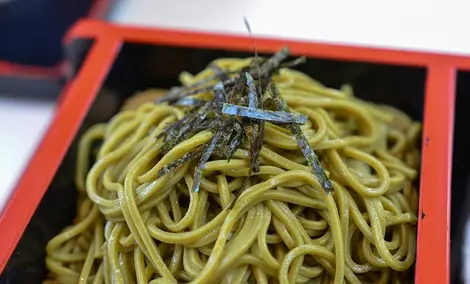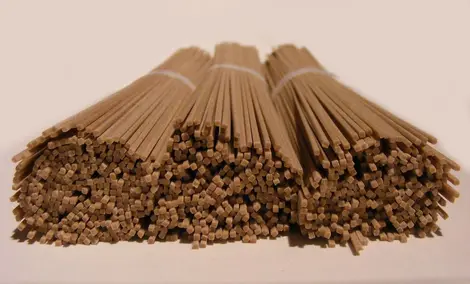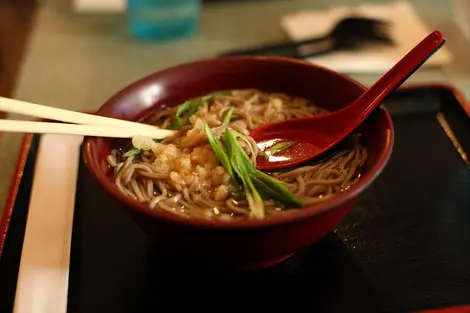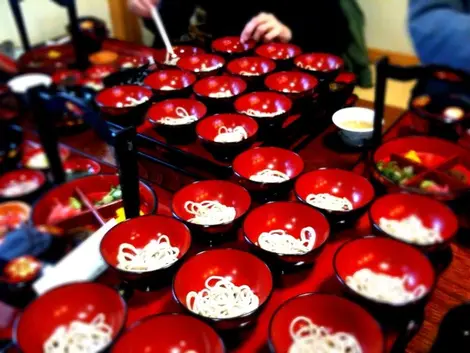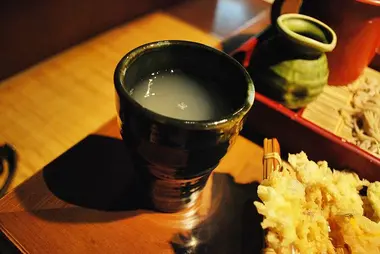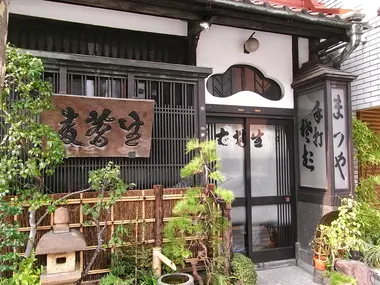Soba, buckwheat noodles 蕎麦
- Published on : 19/12/2019
- by : C.L./ J.R.
- Youtube
Soba are eaten hot or cold
Along with ramen and udon, soba is the most consumed noodles in Japan, forming an integral part of many dishes. These buckwheat flour noodles, which can be eaten in a hot soup or more often cold and dipped, have a rather special place in the hearts and bellies of the Japanese. Learn more about their history and discover the best places to taste them ...
Soba: origin and history
"Soba" originally refers to buckwheat itself. It is a paradox: while buckwheat - or buckwheat - has been a cereal cultivated in Japan since the Jômon era, that is to say since the 15th century BC, soba noodles are one of the few dishes where you can find them (with sobagaki, buckwheat balls).
They are (very) rarely made from 100% buckwheat, but often from a mixture of flour. Also, beware of confusion: yakisoba (fried noodles) and Okinawa soba (noodle soup) is aptly named soba but are not.
As the saying goes, the best soba is " hiki-tate, uchi-tate, yude-tate " freshly ground, made, and cooked.
The most common are zarusoba, served cold, to be dipped in a sauce that varies according to the region (generally high in salt and seasoned with bonito and seaweed). In summer, these cold sobas are very popular, being both refreshing and nourishing, to cope greedily with the blistering Japanese heat. Soba can also be served hot in a broth following the same principle as ramen: they are then called kakesoba.
According to tradition, soba should be slurped, chewed, and then swallowed, no worries for bad etiquette, as it is a tradition for one to slurp and enjoy...
- Read also: The different types of Japanese noodles
Soba, a festive dish
Soba quickly became the dish for major events in life: it is therefore customary to taste it when moving into a new house, but especially to offer hikkoshi-soba to its new neighbors as goodwill. We also taste toshikoshi-soba just before the New Year, to keep healthy and live long: their elongated shape and dense texture are indeed synonymous with longevity and stability.
- Read also: Nagashi-sômen, noodles to catch
Soba enthusiasts will be delighted to learn that there is a soba festival held every fall in Matsumoto (Nagano Prefecture). The opportunity to taste soba from all over Japan, for 500 yen per dish ($4.50/3.75€).
Local variations of soba
A very old dish, soba has many local variations. For example, in Uji, city of tea, it is served seasoned with matcha (green tea powder); in Kyoto, it is served with nishin, cooked fish, called " nishin soba "; in Morioka, it is a fun game which consists of eating as many small bowls of soba as possible (wanko soba).
In most restaurants, sobayu is served at the end of the meal, in a small teapot or a glass containing a soba cooking water: pouring it into the rest of the sauce to be consumed in full to finish the meal.
Discover the technique of making soba
Where to eat soba in Japan?
Soba is easily found in many restaurants across the Japanese archipelago. Just like râmens, udon, or specialties such as sushi and tempura, it would be a shame to go to Japan without tasting these noodles most consumed each year by the Japanese .
Apart from the chain of restaurants Fuji Soba, which allows you to quickly eat soba dishes at a low price, some establishments have made it a specialty, preparing their dough: here are some of our favorite places to tantalize your taste buds and discover these centuries-old noodles during your stay in Japan.
Eat (slurp) soba in Tokyo:
Kanda Matsuya
This ancestral establishment, widely recognized in Tokyo, has opened its doors in 1884, in a beautiful, very authentic building not far from Akihabara. Take a seat in this traditional setting, and taste their hand-crafted soba, seasoned with dashi (konbu broth and dried bonito).
Address: 1-13 Kanda-Sudacho, Chiyoda-ku, Tokyo
Hours: open Monday to Saturday from 11 am to 8 pm (7 pm on Saturday)
Osaka:
Soba Takama
North of Osaka, the capital of food lovers, is the small restaurant Takama. Behind a discreet wooden frontage hides an establishment with one Michelin star (2017). Although Osaka is not the homeland of soba, be sure to try their classic, cold soba, accompanied by excellent vegetable tempura. The restaurant is rather cozy, so to make sure you have a seat, get there as early as possible...
Address: 7 Chome-12-14 Tenjinbashi, Kita Ward, Osaka, 531-0041
Hours: open Wednesday to Monday, 11:30 am to 2:30 pm
Kyoto:
Sobanomi Yoshimura
Without a doubt, THE most recognized restaurant in Kyoto when it comes to soba. There is no risk of making a mistake here... This temple of soba, very close to the Gojo station, offers a wide choice of dinner menus, in a beautiful modern setting but still typically Japanese. Their flagship menu is Moriawase-Zen, which includes sashimi, tempura, cold sobas, various vegetables, and even a soba ice cream! The restaurant also offers a fine sake menu, to be sipped with a dish of noodles.
Address: 420 Matsuyacho, Shimogyo District, Kyoto 600-8105
Hours: open every day from 11 am to 4 pm and from 5 pm to 9 pm





